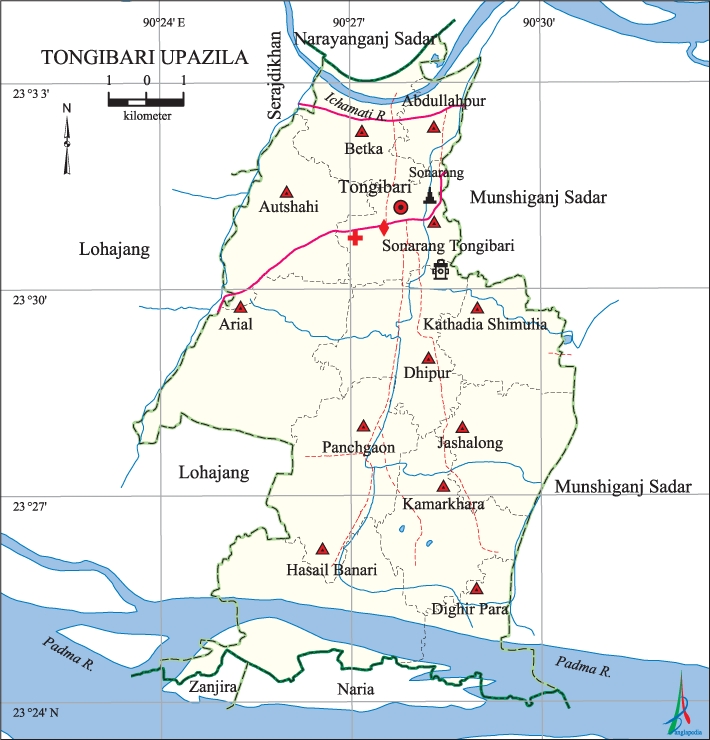Tongibari Upazila
Tongibari Upazila (munshiganj district) area 140.91 sq km, located in between 23°24´ and 23°34´ north latitudes and in between 90°24´ and 90°31´ east longitudes. It is bounded by narayanganj sadar upazila on the north, naria and zanjira upazilas on the south, munshiganj sadar upazila on the east, lohajang and serajdikhan upazilas on the west.
Population Total 197173; male 98120, female 99053; Muslim 181944, Hindu 15208, Buddhist 1, Christian 18 and others 2.
Water bodies Main rivers: padma and ichamati.
Administration Tongibari Thana was turned into an upazila in 1983.
| Upazila | ||||||||
| Municipality | Union | Mouza | Village | Population | Density (per sq km) | Literacy rate (%) | ||
| Urban | Rural | Urban | Rural | |||||
| - | 12 | 102 | 151 | 17706 | 179467 | 1399 | 68.5 | 56.0 |
| Upazila Town | ||||
| Area (sq km) | Mouza | Population | Density (per sq km) | Literacy rate (%) |
| 7.74 | 4 | 17706 | 2288 | 68.5 |
| Union | ||||||||
| Name of union and GO code | Area (acre) | Population | Literacy rate (%) | |||||
| Male | Female | |||||||
| Autshahi 23 | 2561 | 8860 | 9197 | 60.7 | ||||
| Arial 15 | 4017 | 14758 | 14540 | 53.3 | ||||
| Abdullahpur 11 | 834 | 8227 | 8144 | 61.5 | ||||
| Kathadia Shimulia 79 | 1922 | 7071 | 7051 | 57.0 | ||||
| Kamarkhara 71 | 2471 | 8876 | 9502 | 56.1 | ||||
| Dighir Para 47 | 9268 | 4009 | 4244 | 42.1 | ||||
| Dhipur 39 | 2561 | 7917 | 8081 | 57.9 | ||||
| Panchgaon 87 | 3094 | 7180 | 7086 | 56.3 | ||||
| Betka 31 | 2208 | 9357 | 9283 | 62.2 | ||||
| Jashalong 63 | 2355 | 10457 | 10273 | 53.9 | ||||
| Sonarang Tongibari 94 | 1720 | 9034 | 9579 | 66.5 | ||||
| Hasail Banari 55 | 4046 | 2374 | 2073 | 34.6 | ||||
Source Bangladesh Population Census 2011, Bangladesh Bureau of Statistics.
Archaeological heritage and relics Statue of touchstone (now preserved in the National Museum), ancient Math and Temple (Kalibari), Sonarang Jora Mandir.

War of Liberation During the war of liberation in 1971 the Pakistani soldiers killed 15 innocent villagers at Paler Bari in Abdullahpur union. At the end of September, the freedom fighters attacked the police station of Tongibari and acquired a huge amount of arms and ammunitions. A memorial sculpture has been built in the upazila.
For details: see টঙ্গিবাড়ী উপজেলা, বাংলাদেশ মুক্তিযুদ্ধ জ্ঞানকোষ (Encyclopedia of Bangladesh War of Liberation), বাংলাদেশ এশিয়াটিক সোসাইটি, ঢাকা ২০২০, খণ্ড ৯।
Religious institutions Mosque 305, temple 16. Noted religious institutions: Abdullahpur Jami Mosque, Betka Jami Mosque, seven storied Minar Mosque at Pura, Dargah of Fazu Shah.
Literacy rate and educational institutions Average literacy 57.1%; male 56.6%, female 57.6%. Noted educational institutions: Swarnagram RN High School (1898), Abdullahpur Multilateral High School (1899), Sonarang Pilot High School (1900), Outshahi Radhanath High School (1901), Banari Multilateral School (1901), Dighir Para AC Institution (1902), Paikpara High School (1904), Brahmanvita Union High School (1913), Arial Swarnamaye High School (1914).
Cultural organisations Library 48, cultural organisation 3, cinema hall 3.
Main sources of income Agriculture 42.08%, non-agricultural labourer 2.98%, industry 1.01%, commerce 24.33%, transport and communication 3.93%, service 7.01%, construction 1.92%, religious service 0.23%, rent and remittance 5.48% and others 11.03%.
Ownership of agricultural land Landowner 45.84%, landless 54.10%; agricultural landowner: urban 52.84% and rural 45.24%.
Main crops Paddy, jute, potato, betel leaf, vegetables.
Extinct or nearly extinct crops Wheat, sesame, pulse.
Main fruits Mango, jackfruit, banana, papaya.
Fisheries, dairies and poultries This upazila has a number of fishery, dairy and poultry.
Communication facilities Pucca road 103 km, semi-pucca road 15 km, mud road 346 km; waterway 46 km.
Extinct or nearly extinct traditional transport Palanquin, bullock cart.
Cottage industries Goldsmith, blacksmith, potteries, weaving, shital pati, wood work, bamboo work.
Hats, bazars and fairs Hats and bazars are 18, most noted of which are Tongibari Hat, Betka Hat, Subochoni Hat, Dighir Para Hat, Abdullahpur Bazar, Panchgaon Bazar and Dighli Bazar.
Main exports Paddy, jute, potato, banana, vegetables, yarn.
Access to electricity All the unions of the upazila are under rural electrification net-work. However 91.7% of the dwelling households have access to electricity.
Sources of drinking water Tube-well 91.8%, tap 1.4% and others 6.8%. The presence of arsenic in an intolerable level has been detected in the shallow tube well water of the upazila.
Sanitation 84.5% of dwelling households of the upazila use sanitary latrines and 14.3% of dwelling households use non-sanitary latrines; 1.2% of households do not have latrine facilities.
Health centres Upazila health complex 1, satellite clinic 5, family welfare centre 11, clinic 9, diagnostic centre 5, clinic 1.
Natural disasters Many people were victims of the earthquake of 1304, the famine of 1944 and the flood of 1991 these natural disasters also caused heavy damages to settlements, crops and livestock of the upazila.
NGO activities Operationally important NGOs are asa, CARE, brac, proshika. [Masuma Sultana Champa]
References Bangladesh Population Census 2001 and 2011, Bangladesh Bureau of Statistics; Cultural survey report of Tongibari Upazila 2007.
